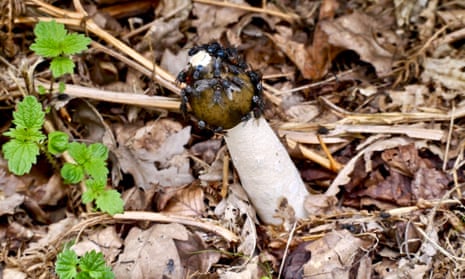The stench of death, the buzz of flies, the indecent exposure – it was a stinkhorn. Rude, erect and smothered in bluebottles, the fungus was at the side of the path to the follies at Hawkstone Park, though bank holiday visitors paid it little attention.
In the 18th century, when this landscape theme park was created, Linnaeus named the fungus Phallus impudicus, literally “shameless phallus”. I imagine visitors then would have been familiar with what the herbalist John Gerard called the “prike mushroom’ in 1597; other folk names included deadman’s cock. Gwen Raverat, the engraver and granddaughter of Charles Darwin (in her 1952 memoir, Period Piece), told a story about her Aunt Hetty (Darwin’s daughter) collecting stinkhorns from the woods and burning them in secret. This was reportedly to protect the morals of the maids but, given Hetty’s neopagan interests, perhaps it was something more fun.
The stinkhorn is saprobic, feeding on dead tree stumps, and its stink, which contains dimethyl trisulfide – the chemical that is given off by necrotic lesions – makes the smell of carrion irresistible to blowflies. Shiny, metallic blue, green or black, the flies cluster on the gooey green gleba – the spore-bearing gel that covers the cap of the fungus and is liquefied by the vibrations of the fly’s proboscis. The fly is attracted to the stinkhorn by the smell but, instead of rotting flesh to lay its eggs in, finds a sugary liquid and gorges on that instead, ingesting the fungal spores suspended in it. The fly benefits from proteins in the gleba that help develop its eggs. The fungus benefits from the fly carrying its spores away and depositing them in faeces. The spores are unaffected by passing through the fly.
Stinkhorns are also more numerous around badger setts, attracting flies that will lay their eggs on dead animals; this disposes of them quickly, reducing the risk to the badger colony from disease. In warm weather (for a macabre example) fly maggots can consume 60% of a human body in less than a week. Sex, death and dirty jokes: unmanaged, irreverent, obscene, stinkhorns infiltrate a landscape made for refined pleasures.

Comments (…)
Sign in or create your Guardian account to join the discussion